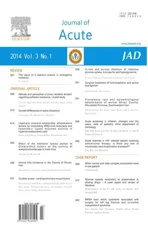Acute reaction to erroneous injection of adrenaline to the patients with hyperthyroidism
2014-04-14BeuyJoobVirojWiwanitkit
Beuy Joob, Viroj Wiwanitkit
1Sanitation 1 Medical Academic Center, Bangkok Thailand
2Visiting Professor, Hainan Medical University, China
Acute reaction to erroneous injection of adrenaline to the patients with hyperthyroidism
Beuy Joob1*, Viroj Wiwanitkit2
1Sanitation 1 Medical Academic Center, Bangkok Thailand
2Visiting Professor, Hainan Medical University, China
Hyperthyroidism is an important endocrine disorder that can be seen around the world. In this disorder, the patient is usually hyperstimulate and palpitation. The effect of thyroid hormone is the explanation. A similar effect can be seen due to adrenaline reaction. In general, the use of adrenaline in the case with hyperthyroidism has to be carefully done. In the present case study, the authors present a case of acute reaction to erroneous injection of adrenaline to the patients with hyperthyroidism.
ARTICLE INFO
Article history:
Received 4 September 2013
Received in revised form 29 September 2013
Accepted 22 October 2013
Available online 20 March 2014
Hyperthyroidism
Reaction
Adrenaline
Error
Injection
1. Introduction
Thyroid hormone is an essential hormone for every human being. It helps normalize the metabolism. However, over level of the hormone can result in clinical problem called hyperthyroidism. Hyperthyroidism is an important endocrine disorder that can be seen around the world. In this disorder, the patient is usually hyperstimulate and palpitation[1,2].
The effect of thyroid hormone is the explanation. In physiology, a similar effect can be seen due to adrenaline reaction[3,4]. In general, the use of adrenaline in the case with hyperthyroidism has to be carefully done.
In the present case study, the authors present a case of acute reaction to erroneous injection of adrenaline to the patients with hyperthyroidism.
2. Case report
The indexed case is a male patient, aged 45 years old, with underlying uncontrolled hyperthyroidism. The case visited to an anti-aging clinic asking for treatment of allergic problem. The patient was ordered dexamethasone intramuscular injection for management. Nevertheless, the in charge practitioner performed incorrectly injection.
The intramuscular injection of 1 ampule of adrenaline was done instead. Suddenly after injection, the patient developed severe headache. His blood pressure shot up to 230/200 mmHg and his heart rate was up to 120/min. The clinical feature of this case seems to be acute thyroid storm. The patient was managed by resting and giving antihypertensive drug. The patients get recovery within 20 min after intensive care.
3. Discussion
The use of adrenaline injection is mainly for critical case such as cases required cardiopulmonary resuscitation or cases with anaphylaxis. For the patients with hypothyroidism, there are few reports on using adrenaline injection.
Sarnoff and Cope firstly raised the issue on injection of adrenaline in hyperthyroidism and mentioned for high awareness in usage[5]. In fact as a potent vasoconstriction, it is recommended not to use adrenaline for the patients with uncontrolled hyperthyroidism[6]. A great increase in blood pressure is the serious concern and can result in fatality[6]. In the present report, the use of adrenaline is by human error. There is a previous case report on accidental injection of adrenaline by the patient and result in finger gangrene[7]. However, the present case is by medical personnel. This can be called a medical disorder or iatrogenic complication.
The patient developed the symptoms of thyroid storm. Luckily the control of severe blood pressure can be done. Lesson learned from this case include a) awareness of drug to be used in injection must be a rule, b) the antihypertensive therapy can effectively control the side effect of adrenaline injection and c) thyroid storm can be triggered by use of adrenaline.
Conflict of interest statement
We declare that we have no conflict of interest
[1] Hashimoto K, Mori M. Guidelines for the diagnosis and management of thyroid disease and their utility. Nihon Rinsho 2012; 70(11): 1857-1864.
[2] Gessl A, Lemmens-Gruber R, Kautzky-Willer A. Thyroid disorders. Handb Exp Pharmacol 2012; 214: 361-386.
[3] Parks KR, Davis JM. Epinephrine, cortisol, endotoxin, nutrition, and the neutrophil. Surg Infect (Larchmt) 2012; 13(5): 300-306
[4] Ziegler MG, Elayan H, Milic M, Sun P, Gharaibeh M. Epinephrine and the metabolic syndrome. Curr Hypertens Rep 2012; 14(1): 1-7.
[5] Sarnoff SJ, Cope O. The effect of atropine and scopolamine on the subsequent injection of epinephrine in thyrotoxic and euthyroid patients. Anesthesiology 1954; 15(5): 484-494.
[6] Kaufman E, Garfunkel A, Findler M, Elad S, Zusman SP, Malamed SF, et al. Emergencies evolving from local anesthesia. Refuat Hapeh Vehashinayim 2002; 19(1): 8-13, 98.
[7] Peyko V, Cohen V, Jellinek-Cohen SP, Pearl-Davis M. Evaluation and treatment of accidental autoinjection of epinephrine. Am J Health Syst Pharm 2013; 70(9): 778-781.
ScholarOne Manuscripts offer the most innovative work flow solutions, from submission and peer review to editorial evaluation
ScholarOne Manuscripts (formerly known as Manuscript Central) remains the industry′s leading solution for scholarly publication. Publishers around the world are fully leveraging international research networks by engaging ScholarOne Manuscripts′ robust features and global scope:
An end-to-end solution used by over 365 societies and publishers, more than 3 400 books and journals, and 13 million users.
A fully customizable solution, including features like plagiarism detection and Cognos Reporting.
Ability to check manuscript status any time, from any location with internet access.
ment heading
10.1016/S2221-6189(14)60020-2
*Corresponding author: Beuy Joob, Sanitation 1 Medical Academic Center, Bangkok Thailand.
E-mail: wviroj@yahoo.com
杂志排行
Journal of Acute Disease的其它文章
- Acute hepatitis with observed increased blood phenytoin level: a case study
- The value of C-reactive protein in emergency medicine
- Attitude and perception of junior resident doctors’ regarding antibiotic resistance - A pilot study
- MRSA toxic shock syndrome associated with surgery for left leg fracture and co-morbid compartment syndrome
- Stromal opacity secondary to preservative in dilating drops - A case report and review of literature
- A case of congenital hypothyroidism presented with dysmyelinization findings
